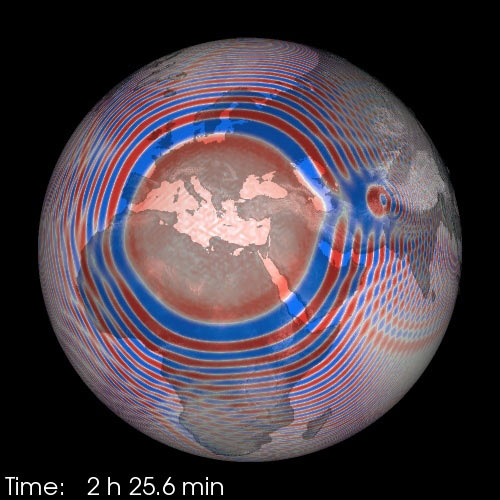Seismology and Geodynamics
Seismology is the study of the composition, structure, and state of the Earth's interior. It encompasses investigating the genesis of earthquakes and the processes of earthquake wave propagation within and along the surface of the Earth.
The lithosphere, the solid outer shell of the Earth, including the crust – the outermost layer on which we live – makes up the ca. 100 km-thick skin of our planet. Beneath this is viscous, semi-fluid material, the mantle. The inside of the Earth is actually a rotating hot drop of sticky fluid held together by its own gravitational force and enclosed in a thin rocky crust. The slowly flowing parts of the deep Earth produce a continuous reshaping and movement of this lithospheric skin, causing it to be broken up into different plates. Movement of material within the mantle is the driving force that ultimately causes earthquakes as the plates separate, collide, and slide against each other. This is also the origin of volcanoes and mountain ranges. Geodynamics and plate tectonics seek to describe and understand all these processes.
The research group Seismology and Geodynamics (SEG), led by Domenico Giardini, uses seismic waves of all kinds and wavelengths to image, with the help of seismic tomography, the three-dimensional structure of the inner parts of the Earth. This relatively young research method has already proved to be by far the most important geophysical method for imaging and understanding the structure of the Earth's interior. An important research focus is to improve and extend this method. Recently, the group succeeded in combining refraction and reflection seismic results – recording waves from man-made explosions – with teleseismic data – records of natural earthquake waves – to produce even more precise tomographic images of the deep subsurface. Inputting different wave types together significantly increases the resolution of the tomographic images. In this way, it has become possible to “see” the topography of the boundary between the lithosphere and the underlying viscous asthenosphere beneath the Alps.

Another focus of research is the further development of surface wave tomography combined with body wave tomography. Here, research today focuses on the geometry of the secondary (S) waves that are produced by earthquakes. Since these S-waves depend on the state of fluidity of the medium through which they travel, they are crucial factors in improving our understanding of the flow properties, the rheology of the lithosphere and Earth's mantle.
Contact
Institut für Geophysik
Sonneggstrasse 5
8092
Zürich
Switzerland
